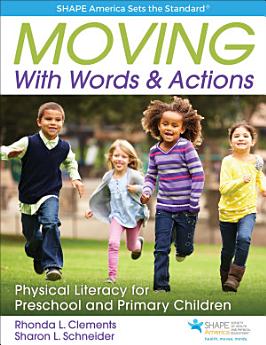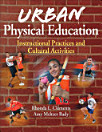Moving With Words & Actions: Physical Literacy for Preschool and Primary Children
About this ebook
Moving With Words & Actions offers early childhood and physical education teachers more than 70 lesson plans that can be used immediately or can be used as models for creating additional lessons. The plans reinforce both physical literacy and language literacy; they use words related to children’s academic learning and understanding of their immediate environment to entice them to move. The lesson plans
• Use an interdisciplinary approach, integrating academic concepts from language arts, math, science, health and nutrition, community awareness, and environmental awareness
• Are highly adaptable for various settings, including those working with individualized education programs and 504 accommodation plans as well as those teaching in limited spaces
• Offer great noncompetitive activities that are perfect for use by recess, lunchtime, and before- and after-school specialists
• Have been field tested according to best practices to ensure age appropriateness
Each lesson plan includes three learning tasks that help children apply a variety of action words and movement concepts to the moderate- to vigorous-intensity physical activities prescribed in the tasks. Most tasks are easy to implement, requiring no equipment or specialized setting. What’s more, all lesson plans address SHAPE America’s National Standards and Grade-Level Outcomes for K-12 Physical Education, so preschool children will have a head start on their kindergarten learning.
This SHAPE America book, based on the authors’ classic Movement-Based Learning, has been completely revamped with new lessons and new material to reflect current research, address the new standards and outcomes, and emphasize physical literacy. Part I offers expert guidance in selecting age-appropriate content, creating and implementing lesson plans, making the most of every lesson, and assessing your students’ learning and progress. In part I, you’ll explore the importance of words in young children’s lives and learn what constitutes an appropriate learning task and how that understanding should inform your teaching. These chapters also highlight two primary instructional strategies for this age group, identify five teaching practices to help student teachers create preservice lessons, and outline three assessment techniques for teachers in early-childhood settings.
Part II supplies the lesson plans themselves, categorized by these units:
• Healthy Bodies (examining body parts and the ways they move, and increasing awareness of healthy nutrition)
• Our Community (enhancing children’s understanding of community helpers in familiar roles)
• Living Creatures (helping children appreciate animals by imitating their movements, behaviors, and characteristics)
• Science and Math (using action rhymes, riddles, and games to learn math and science concepts)
• Language Arts (expanding on children’s language arts and movement vocabularies with alphabet challenges, action poems, movement riddles, and more)
Moving With Words & Actions will help you plan lessons with confidence, use sound instructional strategies, and assess your students effectively as they learn how their bodies function, move, and grow in healthy ways. Children will enjoy the movement activities, which are fun in and of themselves; but, more importantly, they will be taking a solid first step toward becoming physically literate learners who will gain the knowledge, skills, and confidence they need to move with competence in multiple environments and lead active lives.
About the author
Rhonda L. Clements, EdD, is a professor and the director of the master’s of arts in teaching (MAT) program in physical education and sport pedagogy at Manhattanville College in Purchase, New York. At Manhattanville College, she collects data regarding early childhood play activities and teaches about historical and sociocultural issues in sport and physical education.
Clements is the author of 10 books on movement, play, and games. She is past president of the American Association for the Child's Right to Play, a United Nations–recognized association composed of experts in play, games, and sports from 49 countries. The association’s primary purpose is to protect, preserve, and promote play and leisure activities throughout the world.
Clements has written numerous articles related to physical education, including 20 on sport and play factors. She is also a consultant for several manufacturers of sport equipment and playthings and has been interviewed by more than 300 journalists regarding children's right to leisure and physical play. She has presented at 40 international or national conferences and over 60 state or local conferences on topics related to cultural understanding through play and sport. Clements lives in New York City.
Sharon L. Schneider, MS, is an early childhood adjunct assistant professor at Hofstra University in Long Island, New York. At Hofstra University, she teaches all the required courses for undergraduate and graduate students pertaining to child movement, music, rhythm, and play and their integration into academics for early childhood and elementary educators. In addition, she has been a keynote speaker, a consultant for numerous groups, and a visiting scholar at the University of Wisconsin at Madison.
Schneider has served as a national physical activity consultant for Head Start Body Start and the National Center for Physical Development and Outdoor Play, and she has served as a facilitator for I Am Moving, I Am Learning (IMIL). She has been an officer and member of the executive board of the American Association for the Child’s Right to Play, for which she also served as an alternate representative to UNICEF and the United Nations Early Childhood Care and Development in Emergencies Working Group.
Schneider enjoys family adventures, her grandchildren, and the bragging rights she earns playing in her family’s fantasy football league.





